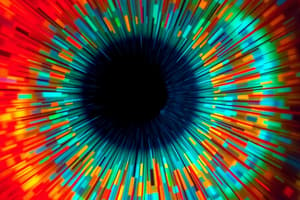Podcast
Questions and Answers
What is presbyopia?
What is presbyopia?
- An eye condition causing visual impairment at all distances
- A refractive error that only affects distance vision
- A condition causing blindness in the elderly
- An age-related refractive error affecting near vision (correct)
How does presbyopia develop as people age?
How does presbyopia develop as people age?
- Presbyopia does not worsen over time
- The eye's ability to focus on distant objects improves
- The lens in the eye becomes more flexible
- The lens loses flexibility, making it harder to focus on near objects (correct)
What is the role of retinoscopes in diagnosing refractive errors?
What is the role of retinoscopes in diagnosing refractive errors?
- Checking the color of the iris
- Determining the presence and degree of refractive errors (correct)
- Measuring blood pressure in the eyes
- Evaluating the health of the cornea
Why are regular eye examinations important for managing refractive errors?
Why are regular eye examinations important for managing refractive errors?
Which treatment options are mentioned for managing refractive errors?
Which treatment options are mentioned for managing refractive errors?
Flashcards are hidden until you start studying
Study Notes
A retinoscope is an optical device used by ophthalmologists and optometrists during eye examinations to determine the presence of refractive errors. These errors can lead to vision problems if left untreated. Refractive errors occur when light rays do not focus precisely on the retina due to variations in the shape of the cornea, lens, or other structures within the eye. Common types of refractive errors include myopia, hyperopia, astigmatism, and presbyopia.
Myopia
Myopia, commonly known as nearsightedness, causes distant objects to appear blurred while near objects remain clear. It occurs when the eyeball's shape becomes too long from front to back, causing light to focus in front of the retina instead of directly on it. This condition can lead to eye strain, headaches, and difficulty seeing road signs or other distant objects.
Hyperopia
Hyperopia, also known as farsightedness, leads to difficulty focusing on close objects while maintaining clear vision for distant ones. It occurs when the eyeball's shape is shorter than usual from front to back, preventing light from precisely focusing on the retina behind the pupil. Symptoms may include eye strain, blurry vision at night, double vision, and fatigue after reading or working for extended periods.
Astigmatism
Astigmatism is an irregularly shaped cornea or lens that causes light to scatter unevenly onto the retina, leading to distorted or blurry vision. It often coexists with myopia or hyperopia and can result in varying degrees of visual impairment depending on its severity.
Presbyopia
Presbyopia is an age-related refractive error that makes it difficult for individuals to focus on near objects. As people grow older, the lens inside their eyes gradually loses flexibility, making it harder to change shape and focus light effectively on the retina. This condition typically begins around age 40 and progressively worsens over time.
Retinoscopes are essential tools for diagnosing these conditions by shining a light into the patient's eye and reflecting off the back surface of the retina. The reflected image allows the examiner to determine the presence and degree of refractive errors, guiding appropriate treatment options such as glasses, contacts, or surgery. Regular eye examinations using a retinoscope ensure early detection and proper management of refractive errors, ultimately preserving and improving overall eye health and vision quality.
Studying That Suits You
Use AI to generate personalized quizzes and flashcards to suit your learning preferences.




